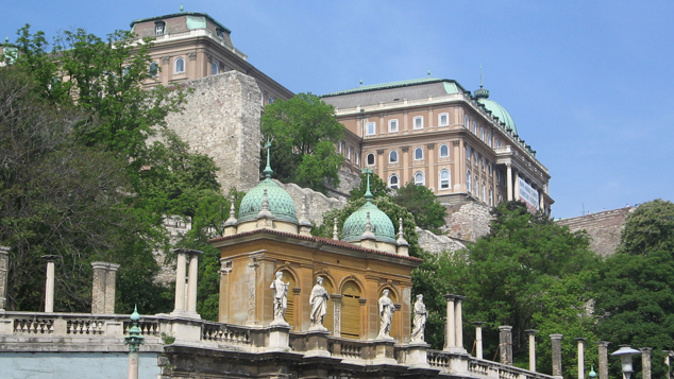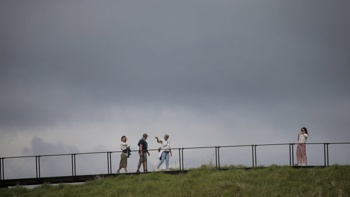
Top of Eastern Europe’s list of “gotta go” destinations is bustling, exotic Budapest, long a punching bag for invading powers and scrapped over by a procession of imperial rulers. Roman emperor Nero was reputedly the first to bathe in the city’s natural hot springs, but the proliferation of Turkish baths is a lasting legacy to the Ottoman era, before the Hapsburgs sent them packing. (As is Budapest’s passion for coffee and paprika.) My favourite spot for a steamy soak is at Gellert. The Art Nouveau designed Gellert Hotel was built during the Golden Age of the late 19th century, and houses a lavish complex of deliciously ornate thermal baths and swimming pools.
Nearby, Gellert Hill pays homage to the city’s patron saint, St. Gellert. In the 9th century, the Venetian missionary was invited to Buda, to help convert the city to Catholicism. A pagan revolt led to Bishop Gellert being placed in a spiky barrel, and rolled off the hill-side into the Danube. His violent death led to him being canonised, and the eponymously named hill now bears a glittering statue in his honour. At the foot of the hill, a cave-like grotto has been developed to imitate the Lourdes grotto, and is one of Christianity’s most sacred sites in Hungary.
As many visitors to the city are surprised to discover, the mighty Danube bisects the twin and distinct settlements of Buda and Pest, that were only officially united as one city in 1873. Necklaced with nine bridges, this vast ribbon of water accentuates the city’s graceful beauty. Nestled amid the verdant hills and tumbling greenery of Buda, the Castle District is the city’s top tourist draw.
This UNESCO-protected treasure chest of historic properties contains churches, mansions, statues, museums, galleries and of course the Royal Palace complex. Budapest’s heady procession of rulers all cracked the whip from this hill-top fortress. The Royal Palace is an architectural mish-mash, modified across the centuries, with various wings and interconnecting courtyards. In previous times, many of the floridly sculpted fountains gushed with wine.
The Hapsburg Empress Maria Theresa added a 200-room palace to the complex in the late 18th century. It was heavily damaged in World War II, and has been undergoing restoration ever since. Buda Castle was destroyed in the war, and it took 30 years to return it to the state you see it in today. Nearby is the Castle Labyrinth which is a 10km-long network of caves, which was used as a very hardy air-raid shelter during the second world war.
Stop by gorgeous Matthias Church ( also known as Virgin Mary Church) , a ginger-bread stone structure that is saturated in history. First built in the 13th century, it was converted into the Great Mosque by the Ottomans three hundred years later, before reverting to Christianity under the Hapsburgs. A ten year long restoration of the church has just been completed, so it’s looking resplendent. What makes this church so striking is the carpet-style ornamentation that graces the columns and walls of the church, in memory of its era as a mosque.
Next door is one of the city’s great panoramic viewpoints. Fishermen’s Bastion was constructed during the Golden Age of the late 1800’s, when the Hapsburgs agreed to greater autonomy for the city. An extravagant and largely decorative building boom ensued, to celebrate Budapest’s new spirit and status. Fishermen’s Bastion features seven turrets, one representing each of the original Hungarian tribes. The most romantic way to ascend the hill to the Castle District, is to take the siklo (funicular), that operates from the Danube riverbank. It was originally built in 1870 to transport the city’s administration clerks up the hill to work. Nowadays, it’s one of Budapest’s essential tourist experiences.
The past century has certainly been a turbulent and torturous period for Hungary; first as a puppet for Nazi Germany, and subsequently a Communist state, with the Soviet Union pulling its strings. Twenty five years ago, Hungary was at the forefront of world history again, as it was the first domino to tip over, triggering the complete collapse of Communism across Eastern Europe. A sobering experience is to take in the House of Terror, which was the Nazi headquarters and the basement used for torture and murder. Post-war, the communists took over the building as the base for its fearsome secret police.
With such a turbulent and blood-stained history, modern day Budapest is interlaid with story upon story about the rise and fall of civilisations. A history so resonant, that you can place your finger in the bullet holes. It is a city of exceptional architectural grandeur, with an inspirational determination to restore all of its treasures.
The most adored structure spanning the Danube is the Chain Bridge: guarded by finely carved stone lions and spectacularly spangled at night, the Chain Bridge was just one of many city icons that were constructed in the Golden Age of the late 19th century. The Hungarian capital wasn’t only unified at this time, and conferred greater independence from its Hapsburg masters, but the city was also celebrating 1000 years of Hungarian settlement, on the banks of the Danube. Art Nouveau and Neo-Renaissance buildings were erected in a spectacular display of new-found pride and belief in Budapest’s future.
A prestigious competition was held to determine the design of the new Hungarian Parliament. Inspired by Britain’s Houses of Parliament, the ornately gothic designed building opened in 1902, replete with turrets and domes. Many of the runners-up in the design competition were applied to the welter of new public buildings and galleries that took shape in Pest. The city boasts no fewer than 60 museums and 90 art galleries.
One of the most iconic cultural shrines is the Opera House. Built in 1884, the interior features seven kilograms of gold and 260 bulbs illuminate the enormous chandelier. The Opera House is in the heart of Andrassy Ave, a 2.5 km-long boulevard, built in the Golden Age, as Pest became a hot-bed for socialites, shopping, wining, dining and entertainment. It unquestionably remains the Champs Elysees of Budapest, with top-end boutique shopping and terraced cafes lining the boulevard.
It is also home to Budapest’s largest church, the Basilica of St Stephen. King Stephen was the historic Hungarian ruler who oversaw the mass-spread of Catholic conversion across his lands. Designed in 1845, construction wasn’t completed until 1905. Mid-way through the building phase, the original dome collapsed, and the entire project was rebuilt. The neo-Renaissance church features uplifting frescoes of many saints. The showpiece attraction is the rather macabre mummified right hand of St Stephen. The relic is preserved in an ornate glass and lead trinket box, that mimics the shape of Matthias Church. Drop a coin in the slot , next to the box, and the saint’s hand lights up. Classy! On St. Stephens Day, August 20, the hand is marched around the square outside the basilica in a revered religious procession.
If you want to sample some authentic Budapest tastes, here’s a few starters.
Budapest Balna shopping complex is an impressive new glass and steel structure in the shape of a whale. It features in The Martian with Matt Damon, and if you like your craft beers, Jonas Sorhaz serves some great brews with edgy names like Pest Control.
The grand old Central Market teems with merchants and the food stalls sell peasant dishes like goulash soup and langos (fried flatbread with toppings). Grab a high stool and enjoy a spicy sausage and a beer for less than NZ$4.
Kert or "ruin" bars are a Budapest invention, continuing to make great use of derelict buildings, awaiting restoration. Such a specimen is Taqueria which was formerly the provisioning depot for Hungarian Railways. Now a spacious garden bar, try a "pinky" (grapefruit vodka shot) or plum palinka (fruit brandy).
Budapest loves its cakes and pastries. A grand old institution is the Gerbeaud Pastry Shop on Vorosmarty Square, founded in 1857, and sure to charm you with its elegant old-world ambience.
Mike Yardley is Newstalk ZB’s Travel Correspondent on Jack Tame Saturdays. 11.20am
Take your Radio, Podcasts and Music with you









